Ara . 20, 2024 14:46 Back to list
flat head dynabolt
Understanding Flat Head Dynabolts An Essential Guide for Construction and Engineering
In the world of construction and engineering, the choice of fasteners is crucial to the integrity and longevity of any structure. Among the myriad of fasteners available, the flat head dynabolt stands out for its versatility and reliability. This article aims to explore the features, applications, and installation of flat head dynabolts.
What is a Flat Head Dynabolt?
A flat head dynabolt, commonly referred to as a dynabolt, is a type of masonry anchor used to secure materials to concrete, brick, or block. The design of the flat head allows for a flush finish with the surface of the material being fastened, which is particularly beneficial for aesthetic purposes. This makes flat head dynabolts an ideal choice for both structural and decorative applications.
Dynabolts are typically constructed from high-strength materials such as stainless steel or galvanized steel, which provide excellent resistance to corrosion and wear. This makes them suitable for use in both indoor and outdoor environments, ensuring durability and longevity in various conditions.
Applications of Flat Head Dynabolts
Flat head dynabolts are widely used in construction and engineering projects due to their strong holding power and adaptability
. Common applications include1. Structural Framing Dynabolts are frequently employed in the assembly of structural frames, particularly in buildings that require additional strength and stability. Their reliability in securing beams and columns makes them a preferred choice among engineers.
2. Installation of Fixtures and Equipment From mounting shelves and cabinets to securing heavy machinery, flat head dynabolts provide a strong anchoring solution. They are often used in warehouses, factories, and home garages for this purpose.
3. Road and Bridge Construction In larger infrastructure projects, such as roads and bridges, dynabolts play a critical role in securing supports and railings. Their ability to withstand substantial loads makes them essential in maintaining safety and structural integrity.
flat head dynabolt

4. Renovations and Extensions When modifying existing structures, flat head dynabolts are ideal for attaching new elements, such as additional walls, facades, or roofing materials. Their ease of installation adds to their appeal during renovation projects.
Installation Process
The installation of flat head dynabolts is straightforward, but proper technique is essential to ensure maximum holding strength. The following steps outline the installation process
1. Preparation Begin by selecting the appropriate size of dynabolt based on the load requirements and the thickness of the materials being fastened. The concrete or masonry surface should be clean and dry for optimal adhesion.
2. Drilling Using the correct drill bit size, create a hole in the substrate material. The depth of the hole should accommodate the length of the dynabolt, ensuring that it reaches adequate anchoring depth.
3. Inserting the Dynabolt Insert the dynabolt into the hole. As you tighten the nut or screw, the expansion mechanism within the dynabolt activates, securely anchoring it to the concrete or masonry.
4. Final Check Once installed, double-check the alignment and tightness of the dynabolt. This step is critical for assessing the stability of the fixture or structure being supported.
Conclusion
Flat head dynabolts are a fundamental component in the construction and engineering design toolkit. Their reliable performance, ease of installation, and aesthetic appeal make them suitable for a wide range of applications. Whether for structural reinforcement, equipment installation, or renovation projects, understanding the advantages and proper use of flat head dynabolts is vital for achieving safe and durable outcomes in any construction endeavor. Investing in high-quality dynabolts not only enhances the longevity of a structure but also contributes to the overall safety and reliability of constructed elements.


